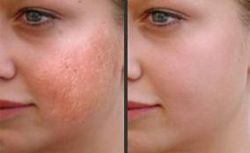Laser Skin Resurfacing

Skin damage can occur due to various factors such as age, emotional stress, sun tan, and acne. Laser skin resurfacing treatment helps to rejuvenate the skin. This is used on skin to treat wrinkles, blemishes, acne scars, lines around eyes and mouth, brown spots, and sun-damaged skin. It offers good results and can be used for all skin types.
Laser skin resurfacing offers an alternative treatment method to dermabrasion. Carbon dioxide (CO2) and Erbium (Er:YAG) lasers are commonly used for laser resurfacing. CO2 lasers help in tightening the skin, whereas Er:YAG lasers help in resurfacing the skin. CO2 vaporizes the upper layers of the damaged skin and Er:YAG penetrates the skin and scatters the heat effects of laser light. Depending on the severity of the skin damage, a combination of these two lasers is used to increase the therapy benefits. These lasers heat up to remove the top layer of the skin and are referred to as ablative lasers. The non ablative lasers target the deeper layers of the skin leaving the top layer intact.
Procedure
This procedure is done under anesthesia. General or local anesthesia is used depending on laser treatment chosen and the area to be treated. The laser light is absorbed by water present in the skin cells and immediately causes vaporization of the top layers of the skin. When the laser light passes over the skin, a mere 30 millionth of an inch of tissue is removed at a time. This allows the physician to treat only as deeply as needed, from removing wrinkles to merely refreshing overall skin appearance. After removing the damaged skin, new skin quickly regrows in its place. The procedure takes a few seconds to over several hours depending on the area to be treated.
Post-operative care
- Follow your doctor’s instructions for skin care which may include frequent soaks, cold compresses, and applying an emollient ointment.
- Avoid exposure to sunlight, fluorescent light, and unfiltered computer screen light.
- Avoid pricking or scrubbing the skin.
- Use recommended antibiotics as prescribed by your physician.
Side effects
The common side effects associated with laser treatments include pain, erythema, oozing and swelling of skin, burning sensation, perioral dermatitis, acne exacerbation, altered skin pigmentation, allergic reactions, and hyperpigmentation.
Indications
Skin conditions– Actinic keratosis, actinic chilitis, acne scars, rhytides, and dermatoheloisis
Cosmetic procedures – Deep wrinkles, periorbital crow’s feet wrinkles, wrinkles of the upper lip, facial lines and scars, acne scars, sun damaged skin, superficial cutaneous lesions, blemishes, to smoothen and tighten the eyelid skin, to remove pigmented spots, and to improve the overall tone and texture of the skin.
Contraindications
Although laser treatment offers significant benefits, it is contraindicated in certain conditions such as bacterial, viral or fungal infections, if isotretinion was used within the previous 6 months, individuals with history of keloid formation, prior radiation therapy, and collagen vascular disease.
Complications
Laser therapy may pose certain complications such as hypertrophic scarring, disseminated infection, and ectropion, a condition where the eyelid turns outward.
